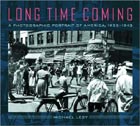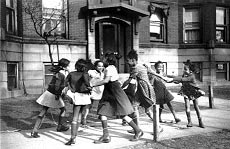Altered
States:
Getting Drunk on Images with Michael Lesy
By
Laura Anne Brooks
 Your
mother might easily mistake photo historian Michael Lesy's
books as picturesque, ideal for door prizes at the next
PTA meeting, only to be bombarded by circus freaks, dead
babies, well hung horses, natural disasters, the perils
of urbanization and the consequences of American imperialism
upon opening. Your
mother might easily mistake photo historian Michael Lesy's
books as picturesque, ideal for door prizes at the next
PTA meeting, only to be bombarded by circus freaks, dead
babies, well hung horses, natural disasters, the perils
of urbanization and the consequences of American imperialism
upon opening.
The
cover of his latest work, Long Time Coming: A Photographic
Portrait of America, 1935-1943, "looks completely
patriotic," notes Lesy, a professor of literary journalism
at Hampshire College in Massachusetts. "But if you
look closely...the woman on the left is missing a leg...
The book is supposed to send a double message. One is
nostalgia and patriotism, which I believe in. The other
is darkness and the complexity of that darkness that's
inside of that sweet, temperate vision of small town life...What
I've always wanted to do was to change people's wiring
for about a thirtieth of a second so they become, in a
really momentary way more alive. In other words, the books
have the quality of a really good drug experience. "
 |
|
Photo
by Edwin Rosskam 1941.
|
|
Long
Time Coming is comprised of book excerpts, correspondences,
shooting scripts, and images taken for the Farm Security
Administration (F.S.A.). The collection chronicles the
team of photographers (names like Walker Evans, Dorthea
Lange, and John Vachon) supervised by Roy Stryker and
sent out by the government on scripted missions to document
American life from the Depression to World War II.
As
far as his writing method is concerned, Lesy is a verbal
collagist. His juxtapositions are oftentimes grim, but
so is the social and political logic he seeks to reveal
by examining the frequent ethical and emotional disregard
of Americans throughout U.S. history.
Inspired
by the Time Life photographic history books organized
by decade, Lesy had an epiphany: "They just bored
the shit out of me," he says, flatly. "I wanted
to do something that said, 'No, you can tell another story...I
[am] going to steadily be chewing my way through the collective
consciousness of the images of the United States, decade
by decade.'"
I
asked Lesy about Paul Vanderbilt, the organizational guru
who archived some 165,600 F.S.A. photos in 1944 at their
final resting-place inside the Library of Congress.
|
|
|
Photo
by John Vachon 1940.
|
|
"Paul
is sort of part of that generation of people who grew up
and realized that there is another way to communicate, and
it's just as powerful and perhaps even more powerful because
it's subversive and tacit. You can change people's thinking
using images without them knowing that you've just messed
with their mind.... Because of Paul I began to work on larger
and larger collections of images.... Stories about Paul
being drunk on images, coming in, and [passing] out on a
pile of photos as he was organizing the whole collection-those
were famous."
For
Long Time Coming, Lesy estimates he viewed 80,000
images, conservatively speaking. "Eventually you'd
pass through this kind of barrier membrane and it's really
like time travel," he says. "People think you
need to do it with machines, but you can actually do it-just
sitting and looking at image after image, one second at
a time. Who knows, if people put electrodes on my head,
they'd probably see I was in an altered state."
Is
the title Lesy's cryptic response to post September 11th,
why us, why now inquiries?
"I
think if you really go deep and make the art, it will
turn out that there are huge unaccountable and unanticipated
links to the rest of the world inside the art making,"
offers Lesy. "So, if there are, and I hope there
are, all sorts of hidden, cunning secrets inside Long
Time Coming that link up with our present predicament,
then I will have done the right thing. You'll know I've
done it."
The
book hit store shelves last month, and as premature as
any addict, Lesy is already craving more images.
|
|
|
Photo
by Arthur Rothstein 1938.
|
|
"I
had hoped to use this book in order to convince people that
another photographic survey of the United States on the
scale that produced the (F.S.A.) file was something that
ought to be done. Maybe people will say, 'Boy it's an amazing
effort at a moment of crisis maybe we should try to do this
again.' I don't think we'll ever be able to do it again.
Because I don't think people are as trusting or as desperate
or naive in the presence of a government photographer, as
they once were.... I'd like to do something that Stryker
did in a way that was more aware and conscious than he was."
Lesy
says he would also like to hire the talent for such an
undertaking and preside over the images, witnessing photographs
roll out in perpetual streams of negatives across his
desk. Like some sort of third party user, he shows no
sign of restraint when it comes to watching what people
shoot.
Order
yours—click here.

|
|
|










